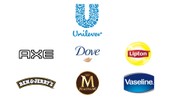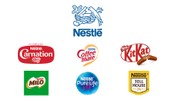At 36, we sometimes have clients come to us with a request to help them with “brand architecture.” They don’t often use that term when they describe the problem they’re having, but we end up letting them know that’s the solution they’re looking for. By brand architecture, we mean the design, organization, and strategy of handling multiple brands under a single portfolio.
When Do You Talk About Architecture?
Sometimes the problem we’re approached with is that our client has new products or services that are really different from what their existing brand does (or that they’re for a very different audience/purpose), and they’re not sure how to market those new offerings. Other times, we may have a company coming to us with a range of brands they own (whether they created them or acquired them over time), and they’re not sure how to handle visually organizing all of their businesses under one umbrella… or whether that’s something they should be doing.
No matter the reason, there are four main strategies of brand architecture we might recommend going with. Identifying which strategy makes the most sense for a client is dependent on their situation.
For anyone interested in reading more about brand architecture, Jill Avery wrote an excellent study for Harvard Business School that outlines all of this information in greater detail. The terms she uses are the ones we use at 36, and they’ve been adopted by a number of creative agencies that specialize in brand strategy.
Strategy 1: Branded House

Google is an excellent example of a branded house strategy (also called a mono-brand strategy). This strategy is, of course, very streamlined because it’s really just different variations of one brand. Each new brand is just a different expression of Google and new logos follow very strict guidelines.
This model works well for Google because their services all strongly connect to technology/interactive, and they’re largely for the same type of person. A large entity like Google can also handle having an extensive list of brands, but other businesses may want to consider whether this method is watering down their brand too much by having an excessive number of iterations.
With this method, every brand has greater synergy and benefits more from the reputation of the company name. On the flip side, each brand also has a greater impact on the reputation of the others. If Gmail was to suddenly stop working tomorrow, people wouldn’t just be bad-mouthing Gmail, they’d be talking about Google.
Just something to keep in mind.
Strategy 2: House of Brands

A house of brands (also called a “family” of brands or a multi-brand strategy) is when there isn’t any kind of visual connection between the parent brand and its child brands. Unilever is a good example of a brand using this strategy because the brands it owns are all incredibly varied. They all offer a wide range of services, are used for many different purposes, and are meant for a wide range of different people.
The emotional benefits that Axe offers its customers are very different than the ones Vaseline offers. Many men used both heavily when they were in high school, but that similarity is a complete coincidence.
If Unilever tried using a branded house strategy, each of the unique personalities it has developed for its brands would be lost. A house of brands tends to command greater shelf-presence as well, and Unilever’s brands are largely sold in stores.
The biggest downside to this strategy is that (without taking care to consolidate brands that overlap closely) there is a risk of some cannibalizing others. Also, the fame a child brand accrues doesn’t necessarily result in more notoriety for the parent brand because there’s no emphasis on the relationship.
Strategy 3: Sub-Branding

A sub-branding system is like a bit like a branded house, but the relationship between the parent brand and its children can change.
With Google, their name is always the first part of their child brands (Google Earth, Google Glass, etc). Microsoft uses a different model where there is a clear visual relationship between it and the brands it creates or acquires, but those sub-brands can sometimes stand on their own.
Sometimes XBox can be the dominant brand in its presentation and sometimes it can totally stand by itself. Other times, the Microsoft brand can have a stronger presence alongside XBox. By doing this, XBox is bringing new characteristics and qualities to Microsoft and diversifying how Microsoft is perceived. Without XBox in its portfolio, Microsoft wouldn’t seem quite as exciting and it certainly wouldn’t have an intense, edgy side to its branding.
Consumers tend to perceive a greater connection between the brands that are part of this strategy than with an endorsed strategy (which we’re talking about next). So, XBox’s performance has more of an effect on the perception of the Microsoft brand.
Strategy 4: Endorsed Branding

Endorsed brands are a little like a house of brands, but the master brand might have some small presence if its name is useful to the child brand. Nestle often uses this strategy, but its brand doesn’t always have to be present in every application of the KitKat logo. The two brands can be separated if it makes sense.
There is greater perceived distance between the two, as a result. This usually means that if a child brand doesn’t preform well, that creates less of an effect on the rest of the umbrella. On the flip side, the endorsement of the parent brand is only really useful if it is well-known for the category. For instance, seeing that a confection is endorsed by Nestle is great. Seeing that a sports car is endorsed by Nestle doesn’t mean anything.
That was a lot!
Yeah, sorry. It was. I guess the key takeaway is that deciding what brand architecture works best for a 36 client requires a clear understanding of what that client’s goals are. How different will the brands be from one another? How beneficial is the presence of the parent brand to the secondary brands? Even though it might look nice to have a collection of uniform brands, is that really the best strategy if the audience/purpose of each is radically different?
When it comes to brand architecture, it’s most important to always remember that the strategy and presentation of the brand should be based on where the goals of the stakeholders meet with what resonates with their target audience. There should always be an effort to remain simple—unless adding complexity results in more order and clarity.
If you’re interested in seeing some of our work in brand architecture, take a look at our case study on DiLuigi Foods and then compare it to the work we did for the child brands featured on their website.
